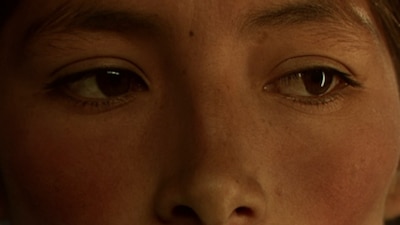Claudia Llosa’s surreal Madeinusa (2006) tells the coming-of-age story of the titular character (Magaly Solier,) a 14-year-old indigenous Quechua girl who lives in the fictional Peruvian town of Manayaycuna. She is crowned “Miss Virgin” during “Holy Time,” a syncretic festival between Jesus’ death and resurrection. “There are no sins during Holy Time,” the townspeople say, because Jesus is not alive and not watching. And so, they have a bacchanalian carnival, drinking in excess, stealing and engaging in illicit, even incestuous sex. Madeinusa is portrayed as both a victim and a victor of this local tradition. By mixing the sacred with the profane, the extraordinary and the ordinary, the abject and the aesthetic, Llosa’s film offers commentary about the possibilities and limits of female self-determination when mores are temporarily loosened. Madeinusa is one of the most successful Peruvian films but also one of the most controversial. Critics accuse Llosa of cultural predation, perpetuating colonial stereotypes of irrational and perverted natives. The film’s inclusion of a white “criollo” stranger from Lima, the “gringo” Salvador (Carlos J. de la Torre), risks reinforcing this perspective. He inserts an outsider’s cosmopolitan gaze into the film, one that is incredulous and pitying of the townspeople. Salvador enacts his name – etymologically meaning “savior” – when he tries to rescue Madeinusa and take her away to Lima. A closer read of the film, however, reveals a biting critique of that cosmopolitan savior-complex: Madeinusa’s name is the phonetic Quechua pronunciation of the garment label “Made in U.S.A,” printed inside Salvador’s shirt; fashion magazines with European models dictate the unrealistic standard of beauty Madeinusa sets for herself; and a Coca-Cola can is nestled among a menagerie of religious effigies. Like Gabriel Garcia Marquez’s fictional town Macondo, Manayaycuna – meaning “the town no one can enter” – represents those places in the world mired in the contradictory promises of globalization. On the one hand, globalization might provide resources and opportunities; on the other, it violently disrupts local cultures. Responding to this geopolitical quandary, Llosa refuses to romanticize native primitivism and, also, refuses to offer globalization as a panacea to native disenfranchisement. Moreover, she actually cast people from the local Quechua population as the central characters of this story, committing to indigenous representation. The film was shot entirely in the village of Canrey Chico, located in the Ancash region in the Peruvian Andes. In recognition of this collaboration, Llosa premiered Madeinusa in a church courtyard in Canrey Chico, and the locals were delighted to see themselves candidly on the big screen in their own town.
by Rebecca Kumar
Madeinusa

Brief Synopsis
Cast & Crew
Claudia Llosa
Yiliana Chong
Carlos De La Torre
Magaly Solier
Juan Ubaldo Huaman
Melvin Quijada
Film Details
Technical Specs
Synopsis
Madeinusa is a sweet girl who lives in an isolated religiously zealous village in mountainous Peru. Everything changes when a geologist from Lima arrives and unknowingly reshapes Madeinusa's destiny.
Director
Claudia Llosa
Crew
Barbara Acosta
Ernest Blasi
Patricia Bueno
Antonio Chavarrias
Leslie Hinojosa
Claudia Llosa
Claudia Llosa
Albert Manera
Albert Manera
Ferran Mengod
Jose-maria Morales
Selma Mutal
Alfredo Neira
Roxana Rivera
Susana Torres
Raul Perez Ureta
Film Details
Technical Specs
Articles
Madeinusa

Madeinusa
Quotes
Trivia
Miscellaneous Notes
Winner of the FIPRESCI Award at the 2006 Rotterdam International Film Festival.
Winner of the John Schlesinger Award, 2007 Palm Springs International Film Festival.
Released in United States 2006
Released in United States January 2006
Released in United States January 2007
Released in United States October 2006
Released in United States on Video April 24, 2007
Shown at Chicago International Film Festival (First & Second Feature Competition) October 5-19, 2006.
Shown at Palm Springs International Film Festival (Awards Buzz - Best Foreign Language Film) January 4-15, 2007.
Shown at Rotterdam International Film Festival (Tiger Awards Competition) January 25-February 5, 2006.
Shown at Seattle International Film Festival (New Directors Competition) May 25-June 18, 2006.
Shown at Sundance Film Festival (World Cinema Dramatic Competition) January 19-29, 2006.
Feature directorial debut for Claudia Llosa.
Released in United States 2006 (Shown at Rotterdam International Film Festival (Tiger Awards Competition) January 25-February 5, 2006.)
Released in United States 2006 (Shown at Seattle International Film Festival (New Directors Competition) May 25-June 18, 2006.)
Released in United States January 2006 (Shown at Sundance Film Festival (World Cinema Dramatic Competition) January 19-29, 2006.)
Released in United States October 2006 (Shown at Chicago International Film Festival (First & Second Feature Competition) October 5-19, 2006.)
Released in United States on Video April 24, 2007
Released in United States January 2007 (Shown at Palm Springs International Film Festival (Awards Buzz - Best Foreign Language Film) January 4-15, 2007.)














